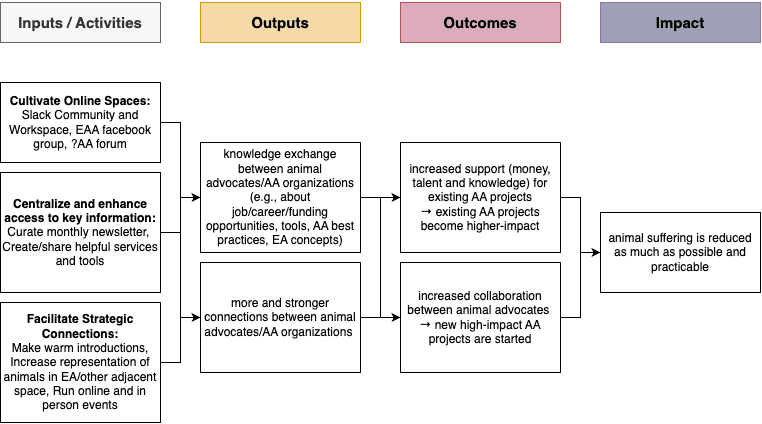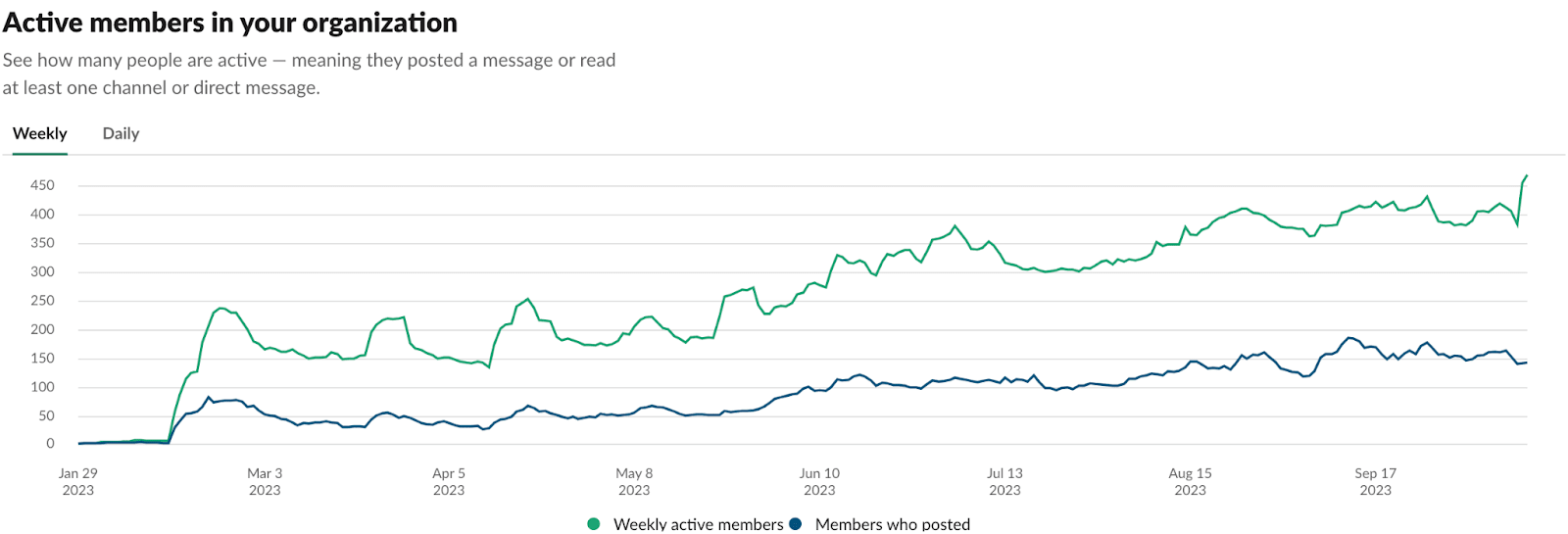Impactful Animal Advocacy: Building Community Infrastructure
By Hive, Constance Li, SofiaBalderson @ 2023-11-21T15:22 (+50)
Tl;dr: Impactful Animal Advocacy (IAA) (edit in 2024 - now called Hive) has grown from a side project in 2022 to a moderately well-recognized online hub for farmed animal advocates with over 2000 community members today. Our aim is to build infrastructure for a better connected animal advocacy movement. We are still a young organization and currently aim to focus on our core programs which include our Slack community, newsletter, and strategic connections.
We are currently operating with 2 full-time and 1 part-time employee (1 is on a break) with a monthly expense rate of 5.5k USD. This is thanks to 2 team members agreeing to work on a volunteer basis. With this state of operations, we have a runway of 5 months secured.
Additional marginal funding would be first used to ensure stable operations in 2024 and then to scale to include other promising programs such as an animal advocacy forum, resource hub, and collaboration with individuals and organizations in neglected regions.
Background
When we first launched 18 months ago, we started with the Impactful Animal Advocacy newsletter. It was meant to be a helpful side project for friends and colleagues who wanted aggregated updates on the farmed animal advocacy movement. This quickly grew into other initiatives including a vibrant Slack community and active work in strategically connecting advocates. After the first year, we received some initial seed funding. This allowed for hiring the project founders for 1 day a week and this later progressed to one of the founders going full-time and the other becoming an advisor. Currently, we believe we have gotten through most of the challenges of early-stage organizational setup including creating and refining SOPs, OKRs, MEL metrics, project/task management systems, and obtaining fiscal sponsorship. We also believe we have built a pretty great team and culture!
Our current goals
- To create exceptionally good online spaces for professional farmed animal advocates to collaborate, exchange information, and be part of a community
- To share high quality resources and information relevant to the work of professional farmed animal advocates
- To serve an online coordination function for the farmed animal advocacy movement
Our primary audience consists of engaged animal advocates who are interested in collaboration, including non-profit employees, project founders, and academics. We also have independent activists, funders, volunteers and established leaders on our platforms.

We've seen rapid growth, with our Slack community reaching over 1,500 members and nearly 60 specialized channels in less than a year. Our newsletter is also gaining traction, with over 1,100 subscribers. Both platforms are community-driven, featuring content and insights shared by our members. Here are testimonials for our Slack and newsletter.
Community stories
Since helping community members is at the center of what we do, our value is best demonstrated in their stories:
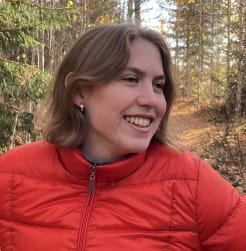 Rosanna Zimdahl | Rosanna Zimdahl, a Masters student from Sweden wasn’t connected to anyone in the movement. She is finishing a degree in MSc Engineering Energy & Environment, and besides that she likes to study systems thinking. She always wanted to contribute to the movement and during a systems mapping course she thought it would be great to apply it to an animal advocacy matter. The Slack space made it possible! She was inspired by the enthusiasm and took the opportunity to start a System Mapping course for farmed animal advocacy. Four other advocates she met on the space joined her to work on the project. If not for IAA, Rosanna wouldn’t have found collaborators to do this which they learnt a lot from, and she will continue applying systems thinking methods to enhance the movement. |
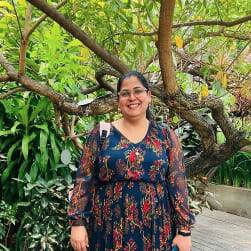 Apoorva | Sofia met Apoorva at Asia Farm Animal Day in Kuala Lumpur where IAA organised a networking event and had a stand. Apoorva was excited about her new non-profit, Animal Law & Policy Network (ALPN). Apoorva told me that she’s looking for the resources and network to start her new organisation successfully. Sofia invited Apoorva to our Slack and Apoorva immediately introduced herself, went through other people’s introductions and reached out to a few organizations that could help her. She started a new channel to connect Indian lawyers and invited her network there too. What’s quite uncanny is that from the other side of the world in NYC, another Indian national interested in law, Sankalpa Ghose, reached out. They decided to collaborate on leading the new channel. Now Apoorva is more connected to the global movement, especially other project founders who can share their experience. She is more aware of other organizations and has a platform where she can build a community for her project! |
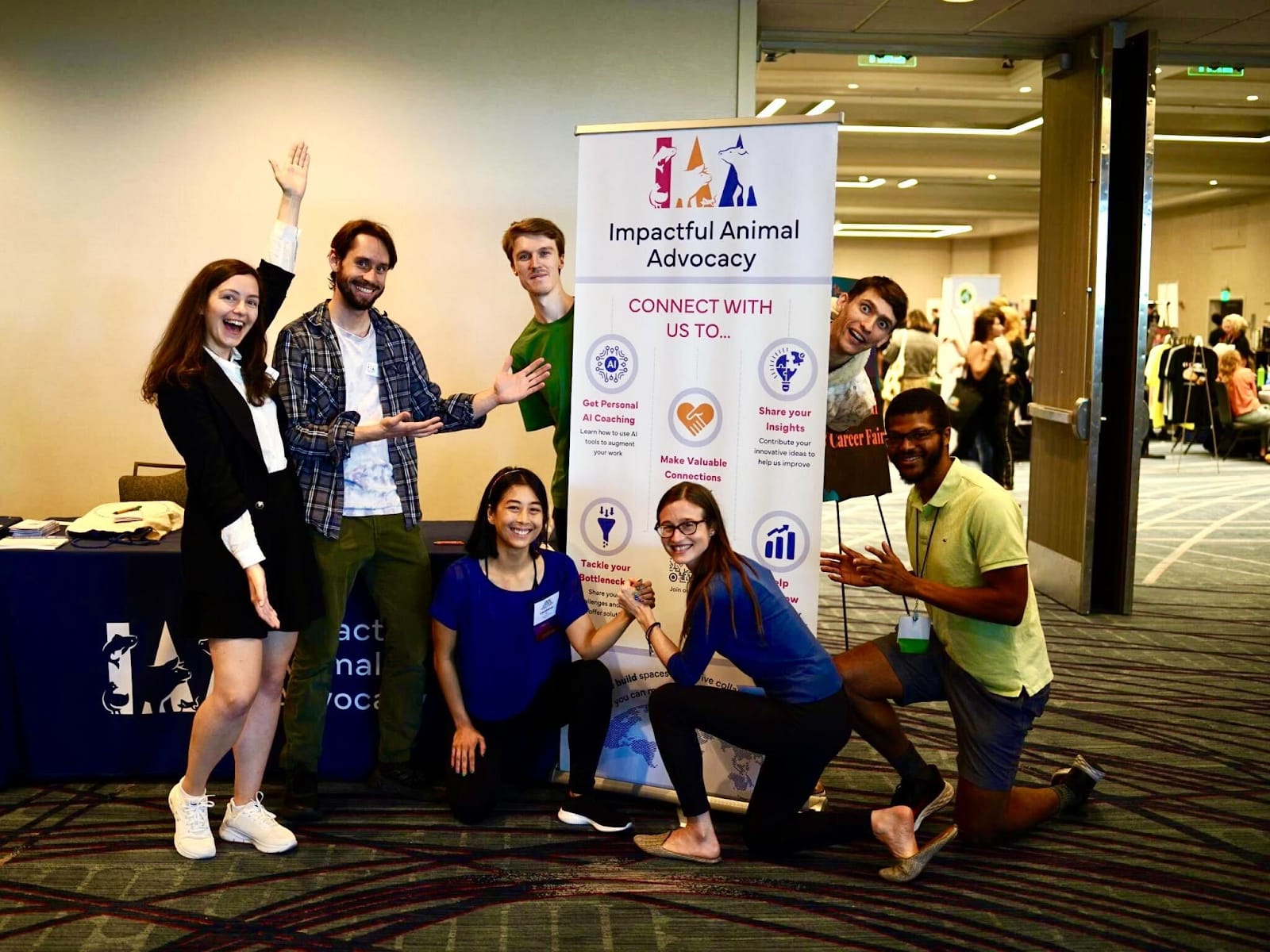
Our team
We have two co-founders working full-time and two contractors who help us with communications and operations.
 | 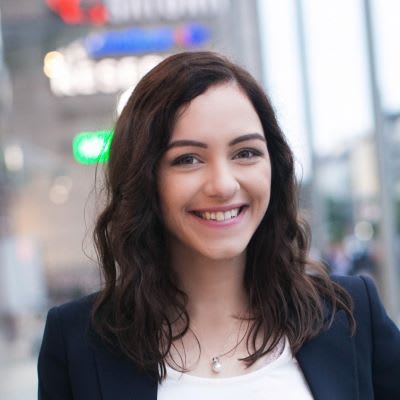 |
|---|---|
| Constance Li | Sofia Balderson |
| Co-founder Constance Li brings entrepreneurial experience and connections cultivated over two decades of involvement in the animal advocacy movement. She’s a board member at Animal Advocacy Africa, a mentor at Magnify Mentoring, and owns a private business. | Co-founder Sofia Balderson has many years of animal advocacy non-profit experience in organisations such as Veganuary, Animal Advocacy Careers, and Equalia ONG, as well as experience in internationalization and project management. |
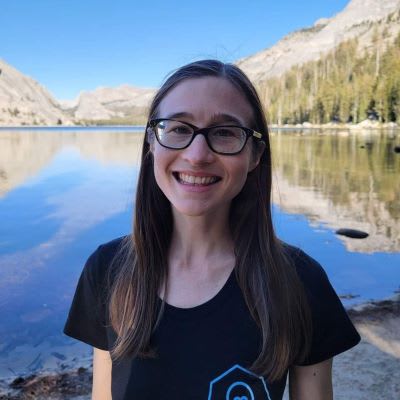 |  |
|---|---|
| Allison Agnello | Helene Kortschak |
| Communications Lead Allison Agnello has worked in communications at Animal Legal Defense Fund and is a local community organizer for the SF Bay Area Effective Altruism group. | Operations and MEL Lead Helene Kortschak also works as a data science consultant for nonprofits, is a Research & Operations volunteer at Healthy Futures Global, and organizes Effective Altruism Graz. |
Our Theory of Change
Updates on IAA projects
Newsletter
- Goal: Deliver quality information, updates, and opportunities to animal advocates and relevant community members, so they can make more informed decisions.
- Stats: 1100+ newsletter subscribers on Substack with >50% open rate and >30-40% opener click-through rate and over 1.5k views per post on average in the past three months.
- Output: We send out a monthly newsletter – see our latest November edition. This month, we are trialing bimonthly sends in an effort to provide more timely information that is less overwhelming in quantity.
Here are some testimonials from regular newsletter readers:
Slack space
- Goal: Connect advocates in between in-person gatherings and conferences, lowering the barrier for collaboration and coordination
- Stats: We have 1,500+ members, of which 400-500 are active weekly members*
*Active users are either a user who has sent 10+ messages in the past 7 days or has created 10 timestamps (logging in, clicking into a new channel, reactions) in at least 3 days out of the last 7.
Slack Analytics graph of our active users (green line) since we started
- Output: Our active community shows a steady, linear growth, a trend we anticipate will continue as we have overcome the ‘cold start' challenge faced by many new communities. Co-founders Sofia Balderson and Constance Li are working as community managers, heavily focusing on building the online space. Just in October, we had:
- 03-help-requests - 17 help requests posted and answered
- 06-jobs-posting - over 60 jobs posted in the channel and a successful collaboration with Animal Advocacy Careers to connect an RSS feed from their job board to the channel
- 02-discussions - 6 in-depth discussions held in the last month
- 05-tools-resources - 23 high-quality resources for animal advocates shared
- Note: we do not have numbers for more meaningful metrics because our first community survey is scheduled for February.
- If you want to take a closer look at what our community is like, you can view this Slack digest we are trialing (however you will need to join the Slack space to view all conversations and threads).
- We have automated several processes including onboarding and 1:1 networking chats.
Here are testimonials from some of our Slack members:
Resource hub
- Goal: Provide evergreen information and resources to the community in order to save time, avoid duplication, and help advocates stay updated about opportunities like conferences and funding.
- Stats: Over 1,000 views to the resource wikis, per Notion Analytics.
- Output: Several community-driven resource wiki pages:
AI for Animals
Co-founder Constance Li has taken the lead on coordinating movement interest in the intersection of AI and animals. She has co-authored posts, coordinated funding opportunities, built a loose coalition group, and supported the creation of a new website. We see this work as timely and important.
The IAA Slack space has been a central hub for AI/Animal conversations since May 2023. We currently have three channels, #ai-tools, #ai-discussion and #ai-images, that facilitate education and collaboration.
While there are a couple of other groups working on AI for animals, our unique value adds are our adaptability, coordination/collaboration capacity, ability to identify gaps in the field, wide recognition as a resource for AI, low entry barrier for involvement, and active Slack channels for ongoing community engagement.
Programme in action:
Aaron Boddy, the co-founder of Shrimp Welfare Project, attended our AI workshop at AVA in LA. He told us that prompted him to later adopt more AI tools for himself and he also helped his team to adopt more AI tools in their workflow. He is currently working with Kyle Behrend from NFPS.ai who we connected with Aaron to implement more AI tools in their operations, such as an AI email responder.
Strategic connections
In recognizing the need for more focused networking in animal advocacy, our Strategic Connections initiative bridges this gap by facilitating targeted connections between advocates, organizations, and projects. Since we are already actively engaged with a variety of organizations, stay up to date with our online community, and attend key conferences, we feel we are especially well-positioned to facilitate connections strategically. This work is highly rewarding and we would feel compelled to do it even if we didn’t have IAA, but the process of networking with others in mind, explaining to both parties why they should meet, making the warm intro, and checking in later on takes a lot of time so we decided to intentionally allocate working time for it.
Programme in action:
Since August 2023, we have successfully initiated over 100 strategic pairings. We believe that some of these matches are highly counterfactual and this program is particularly effective for avoiding project duplication such as in the cases of this potential 1 year project and a decision to hold only 1 instead of 2 FAW retreats in the same month/region.
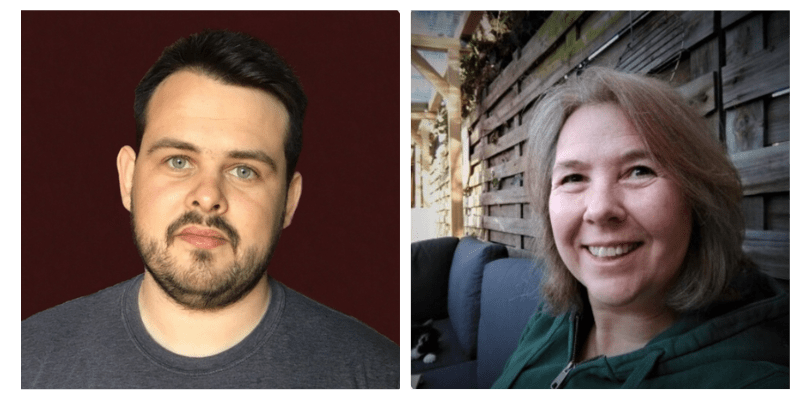
One of the best outcomes we had was a great co-founder pairing that started when Constance met Blake Hannagan at the EA NYC picnic in summer 2023. Blake mentioned he was interested in Monitoring, Evaluation, and Learning (MEL) and gave an impressive demonstration of his knowledge in this subject. He had just started a climate job recently, but it was clear his skills would be a great asset to the animal advocacy movement. A month later, Constance referred him to the Mission Motor co-founder role opening that she saw on the IAA Slack space and encouraged him to explore it. He ended up getting the job!
Community initiatives:
We are cultivating a space where community members can launch their projects. While we are not an incubator and don’t provide seed funding, we believe it’s of value to support them by offering a community for fast feedback, project exposure, and initial launch.
Some examples of organic initiatives in our Slack space include:
- Several EA Forum posts about AI/Animals and the new AI for Animals website
- The Mission Motor using the MEL channel for their training program
- A channel for German-speaking advocates
- A mental health channel
- Independent research comparing the cost-effectiveness of online interventions.
What we would do with additional funding
Current Status: 5.5 months runway left if we continue to maintain operations and programs as they currently are. Actively fundraising for the rest of next year’s 2024-2025 budget.
Funding for Project Maintenance
Minimum Additional Funding Required for 2024: $64,000
Inputs:
- 1 full-time employee, 1 contractor (<0.1 FTE), 1 engaged volunteer (0.2 FTE), 1 full-time volunteer
- Keep Slack Pro and other subscriptions
- Travel and accommodation for major animal advocacy and/or EA conferences (5–7 a year)
Outputs:
- Maintain the community Slack space
- Continue strategic connections
- Maintain a general movement newsletter every 2 weeks
- Run limited AI coordination
- Make limited contributions to the resource wiki
Funding for Organizational Growth:
With additional funding beyond the minimal amount for maintenance ($64k), we could hire full- or part-time staff to do many of the tasks the co-founders are currently responsible for (operations, communications, design) so that each team member has a higher chance of being able to focus on the area of their comparative advantage. We already have excellent candidates in the form of our volunteers. Hiring them would save valuable time and money compared to the typical hiring and onboarding process. We plan to pay an average salary of $60,000 with adjustments for cost of living.
Next we would focus on scaling up our projects and providing services/resources that would help animal advocates be more impactful.
Note: Each tier below represents the total additional funding and includes the activities of all previous tiers. E.g. We’ll need $5k for someone to implement Slack improvements and another $5k would allow us to create focused newsletters, so it will be a total of $10,000.
Additional marginal funding: $5,000–195,000
+ $5,000
- Continue improving the Slack space, especially as we grow towards and past 2,000 members ($5k)
- E.g. Implement solutions to issues found in user interviews, improve quality of replies to posts in the Slack
+ $10,000
- Everything above and
- Create and/or collaborate on regular focused newsletters for different interest groups and regions. Experiment with a different platform to create segmented newsletters. ($5k)
+ $65,000
- Everything above and
- Hire staff for communications/operations/MEL ($55k)
- Devote 5–10x more attention to AI and Animals coordination
- E.g. Continue pursuing the inclusion of animals in the ethical frameworks of AI companies, growing a strong coalition, and updating AI and Animals website and wiki page. Start attending AI-focused events and bringing attention to how AI will affect animals.
- Create and maintain a curated Starter Pack resource guide for each focus area (fundraising, wild animals) on the Slack.
- Coordinate with other farmed animal capacity builders on the creation of shared databases for resources, candidates, etc.
+ $130,000
- Everything above and
- Hire staff to manage content for a forum about farmed animal advocacy. Currently, a dedicated forum for this movement does not exist, and productive discussions about these issues like those in the IAA Slack have a limited audience reach. The animal welfare section of the EA Forum also results in productive discussions but doesn’t appeal to a large segment of the animal advocacy movement. We have been working with the EA Forum online team and believe upfront forum setup costs will be relatively low with the recently updated codebase. We are currently working with a volunteer developer. However, to ensure the forum's engagement and quality, we were advised it would require a content specialist, making funding for this role the primary constraint for the project. ($65k)
+ $195,000
- Everything above and
- Hire a Slack community manager. This role is currently being shared among the existing team members and includes driving productive conversation, ensuring guidelines are followed, connecting with people for 1:1s, onboarding new members, and managing volunteer moderators and channel leads. This will also involve improving the space so that we can provide more value to advocates who are interested and able to collaborate and coordinate. We are also excited about growing the community in different regions, such as the global south. Our next potential project is connecting advocates according to a specific skill, such as operations or campaigns, to learn from each other and share resources. ($65k)
Uncertainties
Impact and tractability
Community building projects are often hard to measure. While we have developed an extensive MEL system with defined early indicators, we are unlikely to understand the full extent of our impact, especially the more ambiguous second and third-order consequences of our work.
Project selection
There are many different opportunities and potential projects for us to pursue within the meta farmed animal advocacy space, and we have uncertainties about whether we have chosen optimally. We recently created a weighted factor model for our programs, but are still quite uncertain about which ones are the best for our theory of change. As we get more impact indicators, we will have more confidence in our project selection.
Branding
We are not sure if the current branding is appropriate and resonates with our audience. We are also concerned that the name feels too “EA” and prevents potential collaborations in the animal advocacy movement due to stigma. We are currently considering rebranding and would be open to any suggestions.
Continuous engagement
We have seen continuous growth in engagement on our platform. As community dynamics will inevitably change with growth, we are uncertain about how it will develop in the next year and beyond. We will need to find solutions to continue providing value to members while limiting any overwhelm. This will likely require close monitoring and careful experimentation with new guidelines, automation, or platforms.
Why donate to IAA?
We understand that there are many different funding opportunities within the animal welfare space so we listed some characteristics of individuals that IAA would be a good fit for.
- If your theory of change puts a large weight on strengthening the animal advocacy movement in order to reduce animal suffering
- If you’re particularly interested in supporting farmed animal advocates in regions where it is hard for individuals to travel to major conferences for visa or financial reasons and can especially benefit from a helpful online community
- If you’re an IAA community member who benefits from our resources, donating is a helpful way to show your support. This also makes us more sustainable and less reliant on major funders.
- If you are excited about supporting a small, but up-and-coming project at an early stage of development.
How to Contribute
Unrestricted donations can be made online.
If you are interested in a certain facet of our work and want to make a restricted donation for a particular project, we are happy to work with you. Please contact Sofia at sofia@impactfulanimaladvocacy.org.
Finally, you can also contribute your ideas, talents, and time as a valued community member.
Vaidehi Agarwalla @ 2023-11-21T23:04 (+8)
Thanks for this! A few questions:
-
Of the 100 strategic pairings you did, how would you break down the impact / what was the outcome of the pairings?
-
how do you think the AI for animals group will benefit animals? E.g. what kind of concrete outcomes do you expect to see?
-
do you have a user survey or feedback on the relative value of the different services you provide? How do you prioritize between different initiatives?
SofiaBalderson @ 2023-11-24T19:18 (+1)
Hey Vaidehi, thanks a lot for reading and your questions:)
1. Of the 100 strategic pairings you did, how would you break down the impact / what was the outcome of the pairings?
We have only started doing strategic connections actively in August and have a follow-up time after three months of connections, so we don’t know the outcome for the majority yet. We have a system set up that notes down the input (resource provided, short or long consultation, funding, warm introduction or others) and output (tool adopted, meaningful or impactful connection, project consolidation or extension, knowledge gained, funding/volunteering/job opportunity gained, time saved, project started, co-founder paired, other). Some of the connections we have checked on had resulted in some outcomes from the above, some had no outcome, but the data we got won't be informative yet. It is possible that long-term the impact of these connections can change too. We are going to check in on the connections in February after the survey and report back on the data in a post.
2. how do you think the AI for animals group will benefit animals? E.g. what kind of concrete outcomes do you expect to see?
It’s hard to know at this point what concrete outcomes will arise. The most ideal would be if we were able to establish a dialogue with companies that are involved with precision livestock farming and influence them to prioritize animal welfare higher than they otherwise would have. There is usually a point in intensive farming where welfare and economic gain are opposed and we would like to be in a position to influence these tradeoff decisions. With our initiatives to have animals included in the ethics frameworks in LLM companies, we are hoping that animals will have more consideration in future applications of the LLM. One hypothetical could be if someone asked for the steps to build a highway responsibly and the LLM would be more likely to advise to find and avoid cutting through any animal migration routes. Of course, we don’t expect to be able to do this on our own. Our focus on writing about AI and animals would ideally result in others feeling motivated to work on it too so this field grows faster and we can better take advantage of this window of time where changes in AI policy are easier to make. Finally, the work we do with helping animal advocates to use AI to improve their work efficiency aims to save valuable time and money in the movement.
3. do you have a user survey or feedback on the relative value of the different services you provide? How do you prioritize between different initiatives?
We haven’t done extensive user surveys yet but we have done some user interviews (35 1:1 conversations) based around the needs of the community members and have incorporated some of their feedback into our strategy and programs. We also have continuous feedback being requested through all our channels.
Initially, because we started from such a small project, we were guided mainly by the feedback on the MVP experiments we conducted (which were in turn chosen because we identified a gap we thought was worth filling). Once the MVP launched and was converted into a program, the content was largely community-driven (e.g. members requesting channels). To help us decide whether a program is worth continuing, we look at the engagement indicators such as newsletter and Slack channel views, as well as talking to community members to find out whether a service is valuable. During these conversations we sometimes find more tangible impact.
We created a weighted factor model to help us choose between different programs (with Potential Impact, cost, feasibility, neglectedness and scalability as criteria). So far the highest ranking are the AI and Animals, the Slack space, resource wiki and the newsletter, with the Forum following close (largely because of the uncertainty around us being able to overcome the “cold start”). However, this model is initial, and we will be updating it based on the results of the community survey we’ll do in February.
We always have new ideas, either from ourselves or suggested. We will also ask this question in our upcoming survey to see how impactful and/or valuable these programs are to the community members and if there is something else people would like to see.
